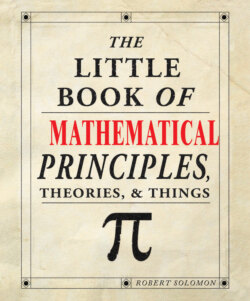Читать книгу The Little Book of Mathematical Principles, Theories & Things - Robert Solomon - Страница 25
На сайте Литреса книга снята с продажи.
3rd century BC Greece Euclid’s Elements Euclid (c. 325–265 BC)
ОглавлениеThese are a compilation of geometric theorems.
_______________
Euclid’s Elements lists and proves the geometrical results of his day. It has survived as a model of logical reasoning and as a basis for learning mathematics for 2,000 years.
Euclid’s Elements of Geometry consists of 13 books that cover the mathematics known during the time of writing. It is largely a compilation of other mathematicians’ results rather than original work by Euclid himself, but its structure, a chain of theorems proceeding logically from clearly stated definitions and axioms, is due to Euclid.
The collection contains all traditional school geometry. The fifth proposition is that the base angles of an isosceles triangle are equal, the 32nd is that the sum of the angles of a triangle is 180° and the 47th is Pythagoras’s Theorem.
It is very much pure mathematics. When a pupil at Euclid’s academy asked what gain he could make from it, Euclid contemptuously told his slave to throw the student a coin.
The theorems are all phrased in terms of geometry, as was nearly all Greek mathematics, but a large part of the work lays the foundation for number theory.
The book was used continuously for teaching mathematics for 2,000 years. British intellectual Bertrand Russell was introduced to the Elements at the age of 11 and recorded the impression it made on him:
This was one of the great events of my life, as dazzling as first love. I had not imagined there was anything so delicious in the world.
